Strength and Cyclic Properties of Additive vs. Conventionally Produced Material AlSi10Mg
Abstract
1. Introduction
2. Materials and Methods
3. Results
3.1. Analysis of AlSi10Mg Strength Properties
3.2. Analysis of AlSi10Mg Cyclic Properties
4. Discussion
5. Conclusions
- Static tests of AlSi10Mg show lower values of Young’s modulus in AM technologies compared to conventional casting of the material, but on the contrary, an increase of strength in AM technologies.
- Cyclic tests of AMSi10Mg show a significant anisotropy depending on the direction of material addition for AM technology and a significant decrease in cyclic properties to the detriment of AM technology.
- The theoretical achievement of cyclic property isotropy by advances in AM technology does not erase the difference from the cyclic properties of convectively cast material, which is likely due to the physical limits of current AM technologies.
Author Contributions
Funding
Institutional Review Board Statement
Informed Consent Statement
Data Availability Statement
Conflicts of Interest
References
- Gorelik, M. Additive Manufacturing in the Context of Structural Integrity. Int. J. Fatigue 2016, 94, 168–177. [Google Scholar] [CrossRef]
- Yadollahi, A.; Shamsaei, N. Additive manufacturing of fatigue resistant materials: Challenges and opportunities. Int. J. Fatigue 2017, 98, 14–31. [Google Scholar] [CrossRef]
- Herzog, D.; Seyda, V.; Wycisk, E.; Emmelmann, C. Additive manufacturing of metals. Acta Mater. 2016, 117, 371–392. [Google Scholar] [CrossRef]
- Xu, W. Direct Additive Manufacturing Techniques for Metal Parts: SLM, EBM, Laser Metal Deposition. Encycl. Mater. Met. Alloy 2022, 3, 290–318. [Google Scholar] [CrossRef]
- Moriaux, F. Additive Manufacturing for Space Application. 2015. Available online: https://speakerdeck.com/altairhyperworks/additive-manufacturing-for-spaceapplication-franck-mouriaux-ruag-space (accessed on 1 February 2023).
- Molaei, R.; Fatemi, A. Fatigue Design with Additive Manufactured Metals. Procedia Eng. 2018, 213, 5–16. [Google Scholar] [CrossRef]
- Margetin, M.; Chmelko, V.; Šulko, M.; Ďurka, R.; Koščo, T. Fatigue Lifetime Analysis of a Bicycle Frame Made by Additive Manufacturing Technology from AlSi10Mg. Metals 2022, 12, 1277. [Google Scholar] [CrossRef]
- Pekok, M.A.; Setchi, R.; Ryan, M.; Han, Q.; Gu, D. Effect of process parameters on the microstructure and mechanical properties of AA2024 fabricated using selective laser melting. Int. J. Adv. Manuf. Technol. 2021, 112, 175–192. [Google Scholar] [CrossRef]
- Zhang, J.; Yuan, W.; Song, B.; Yin, S.; Wang, X.; Wei, Q.; Shi, Y. Towards understanding metallurgical defect formation of selective laser melted wrought aluminum alloys. Adv. Powder Technol. 2022, 1, 100035. [Google Scholar] [CrossRef]
- Liu, Q.; Wu, H.; Paul, M.J.; He, P.; Peng, Z.; Gludovatz, B.; Kruzic, J.J.; Wang, C.H.; Li, X. Machine-learning assisted laser powder bed fusion process optimization for AlSi10Mg: New microstructure description indices and fracture mechanisms. Acta Mater. 2020, 201, 316–328. [Google Scholar] [CrossRef]
- Sames, W.J.; List, F.A.; Pannala, S.; Dehoff, R.R.; Babu, S.S. The metallurgy and processing science of metal additive manufacturing. Int. Mater. Rev. 2016, 61, 315–360. [Google Scholar] [CrossRef]
- Lu, H.; Pan, J.; Gu, Y.; Xiao, J.; Ma, C.; Yu, N. Comparison of melt evolution and flow mechanisms of Inconel 718, Ti6Al4V, 304 stainless steel, and AlSi10Mg manufactured by laser powder bed fusion, structures, and properties after heat treatments. Mater. Sci. Eng. A 2023, 865, 144649. [Google Scholar] [CrossRef]
- Lewandowski, J.J.; Seifi, M.; Clarke, D.R. Metal Additive Manufacturing: A Review of Mechanical Properties. Annu. Rev. Mater. Res. 2016, 46, 151–186. [Google Scholar] [CrossRef]
- Aboulkhair, N.T.; Simonelli, M.; Parry, L.; Ashcroft, I.; Tuck, C.; Hague, R. 3D printing of Aluminium alloys, Additive Manufacturing of Aluminium alloys using selective laser melting. Prog. Mater. Sci. 2019, 106, 1873–2208. [Google Scholar] [CrossRef]
- Fousová, M.; Dvorský, D.; Michalcová, A.; Vojtěch, D. Changes in the microstructure and mechanical properties of additively manufactured AlSi10Mg alloy after exposure to elevated temperatures. Mater. Charact. 2018, 137, 119–126. [Google Scholar] [CrossRef]
- Uzan, N.E.; Schneck, R.; Yeheskel, O.; Frage, N. Fatigue of AlSi10Mg specimens fabricated by additive manufacturing selective laser melting (AM-SLM). Mater. Sci. Eng. 2017, 704, 229–237. [Google Scholar] [CrossRef]
- Leon, A.; Shirizly, A.; Aghion, E. Corrosion Behavior of AlSi10Mg Alloy Produced by Additive Manufacturing (AM) vs. Its Counterpart Gravity Cast Alloy. Metals 2016, 6, 148. [Google Scholar] [CrossRef]
- Thijs, L.; Kempen, K.; Kruth, J.P.; Van Humbeeck, J. Fine-structured aluminium products with controllable texture by selective laser melting of pre-alloyed. AlSi10Mg powder. Acta Mater. 2013, 61, 1809–1819. [Google Scholar] [CrossRef]
- Trevisan, F.; Calignano, F.; Lorusso, M.; Pakkanen, J.; Aversa, A.; Ambrosio, E.P.; Lombardi, M.; Fino, P.; Manfredi, D. On the Selective Laser Melting (SLM) of the AlSi10Mg Alloy: Process, Microstructure, and Mechanical Properties. Metals 2017, 10, 76. [Google Scholar] [CrossRef]
- Beretta, S.; Romano, S. A comparison of fatigue strength sensitivity to defects for materials manufactured by AM or traditional processes. Int. J. Fatigue 2017, 94, 178–191. [Google Scholar] [CrossRef]
- Chen, B.; Moon, S.K.; Yao, X.; Bi, G.; Shen, J.; Umeda, J. Strength and strain hardening of a selective laser melted AlSi10Mg alloy. Scr. Mater. 2017, 141, 45–49. [Google Scholar] [CrossRef]
- Suryawanshi, J.; Prashanth, K.G.; Scudino, S.; Eckertb, J.; Prakash, O.; Ramamurty, U. Simultaneous enhancements of strength and toughness in an Al-12Si alloy synthesized using selective laser melting. Acta Mater. 2016, 115, 285–294. [Google Scholar] [CrossRef]
- Tang, M.; Pistorius, P.C. Oxides, porosity and fatigue performance of AlSi10Mg parts produced by selective laser melting. Int. J. Fatigue 2017, 94, 192–201. [Google Scholar] [CrossRef]
- Gockel, J.; Sheridan, L.; Koerper, B.; Whip, B. The influence of additive manufacturing processing parameters on surface roughness and fatigue life. Int. J. Fatigue 2019, 124, 380–388. [Google Scholar] [CrossRef]
- Azri, M.A.; Shaari, M.S.; Ahmad Kamal Ariffin, A.K.; Abdullah, S. Microstructure, Mechanical Properties and Fatigue Behavior of AlSi10Mg: An Additive Manufacturing Material. Int. J. Eng. Technol. 2018, 7, 186–190. [Google Scholar]
- Gerov, M.V.; Vladislavskaya, E.Y.; Terentev, V.F.; Prosvirnin, D.V.; Antonova, O.S.; Kolmakov, A.G. Fatigue Strength of an AlSi10Mg Alloy Fabricated by Selective Laser Melting. Russ. Metall. 2018, 4, 392–397. [Google Scholar] [CrossRef]
- Basquinm, O.H. The exponential law of endurance tests. Am. Soc. Test Mater. Proc. 1910, 10, 625–630. [Google Scholar]
- Plessis, A.; Beretta, S. Killer notches: The effect of as-built surface roughness on fatigue failure in AlSi10Mg produced by laser powder bed fusion. Addit. Manuf. 2020, 35, 101424. [Google Scholar] [CrossRef]
- Kliman, V. Probabilistic approach to operational fatigue-life evaluation. Part II. Calculation of fatigue-life distribution function with respect to inhomogeneity of material properties and random loading. Kov. Mater. Met. Mater. 1999, 37, 18–33. [Google Scholar]
- Yadollahi, A.; Mahmoudi, M.; Elwany, A.; Doude, H.; Bian, L.K.; Newman, J.C. Fatigue-life prediction of additively manufactured material: Effects of heat treatment and build orientation. Fatigue Fract. Eng. Mater. Struct. 2020, 43, 831–844. [Google Scholar] [CrossRef]
- Beretta, S.; Gargourimotlagh, M.; Foletti, S.; du Plessis, A.; Riccio, M. Fatigue strength assessment of “as built” AlSi10Mg manufactured by SLM with different build orientations. Int. J. Fatigue 2020, 139, 105737. [Google Scholar] [CrossRef]
- Cáceresa, C.H.; Selling, B.I. Casting defects and the tensile properties of an Al Si Mg alloy. Mater. Sci. Eng. 1996, 220, 109–116. [Google Scholar] [CrossRef]
- Zhuo, L.; Wang, Z.; Zhang, H.; Yin, E.; Wang, Y.; Xu, T.; Li, C. Effect of post-process heat treatment on microstructure and properties of selective laser melted AlSi10Mg alloy. Mater. Lett. 2019, 234, 196–200. [Google Scholar] [CrossRef]
- Sajadi, F.; Tiemann, J.-M.; Bandari, N.; Cheloee Darabi, A.; Mola, J.; Schmauder, S. Fatigue Improvement of AlSi10Mg Fabricated by Laser-Based Powder Bed Fusion through Heat Treatment. Metals 2021, 11, 683. [Google Scholar] [CrossRef]
- Enrique, P.D.; Keshavarzkermani, A.; Esmaeilizadeh, R.; Peterkin, S.; Jahed, H.; Toyserkani, E.; Zhou, N.Y. Enhancing fatigue life of additive manufactured parts with electrospark deposition post-processing. Addit. Manuf. 2020, 36, 101526. [Google Scholar] [CrossRef]


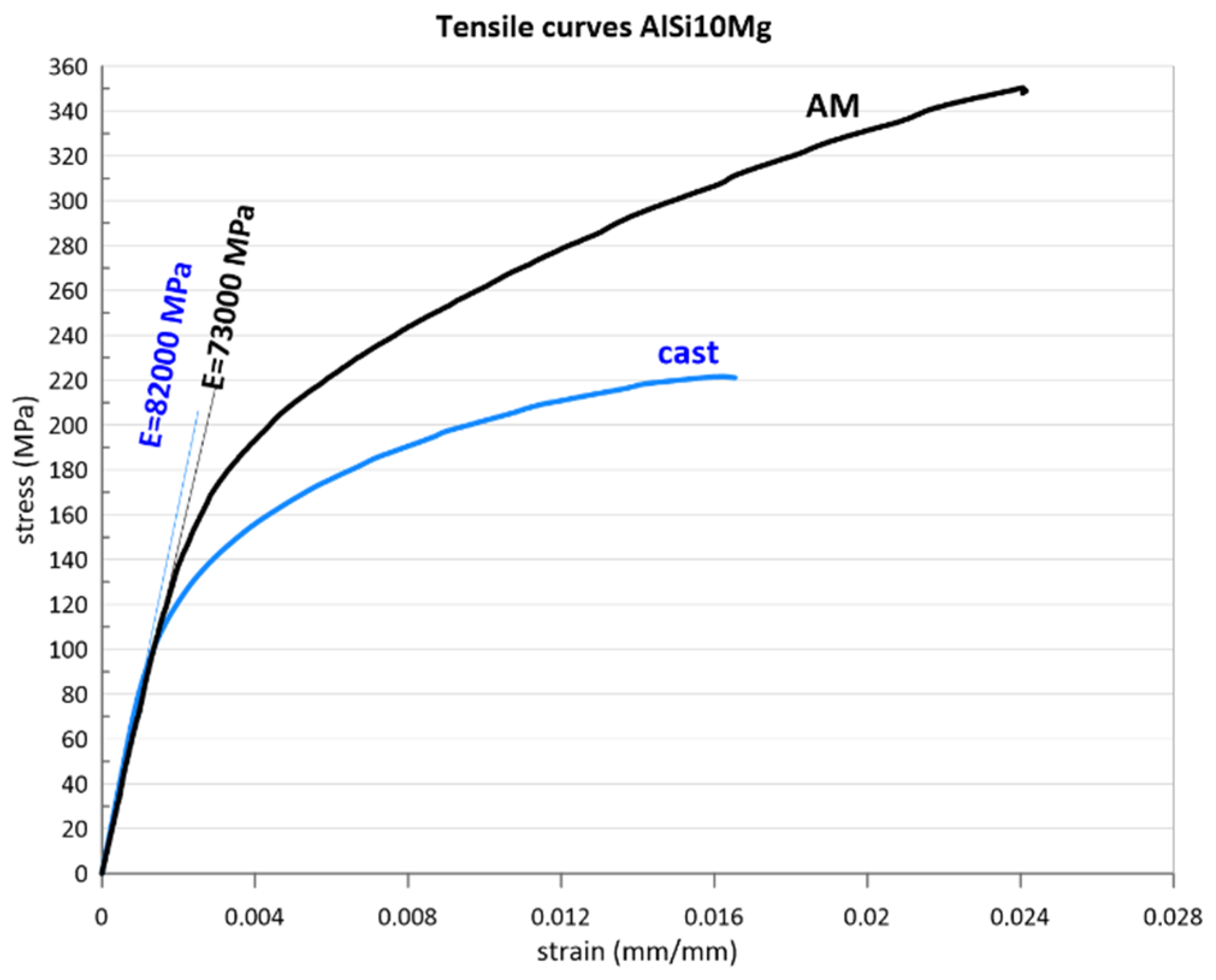

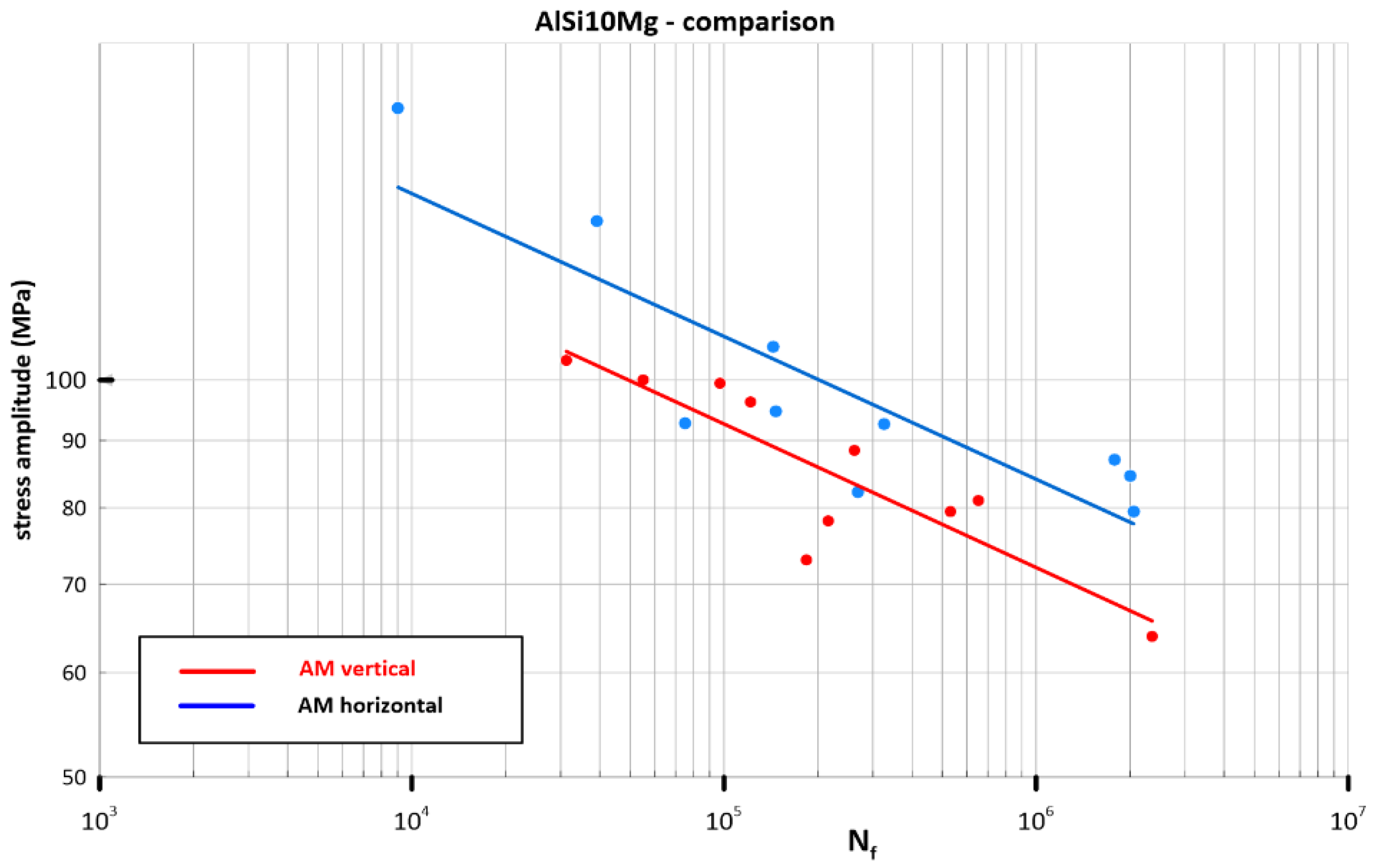
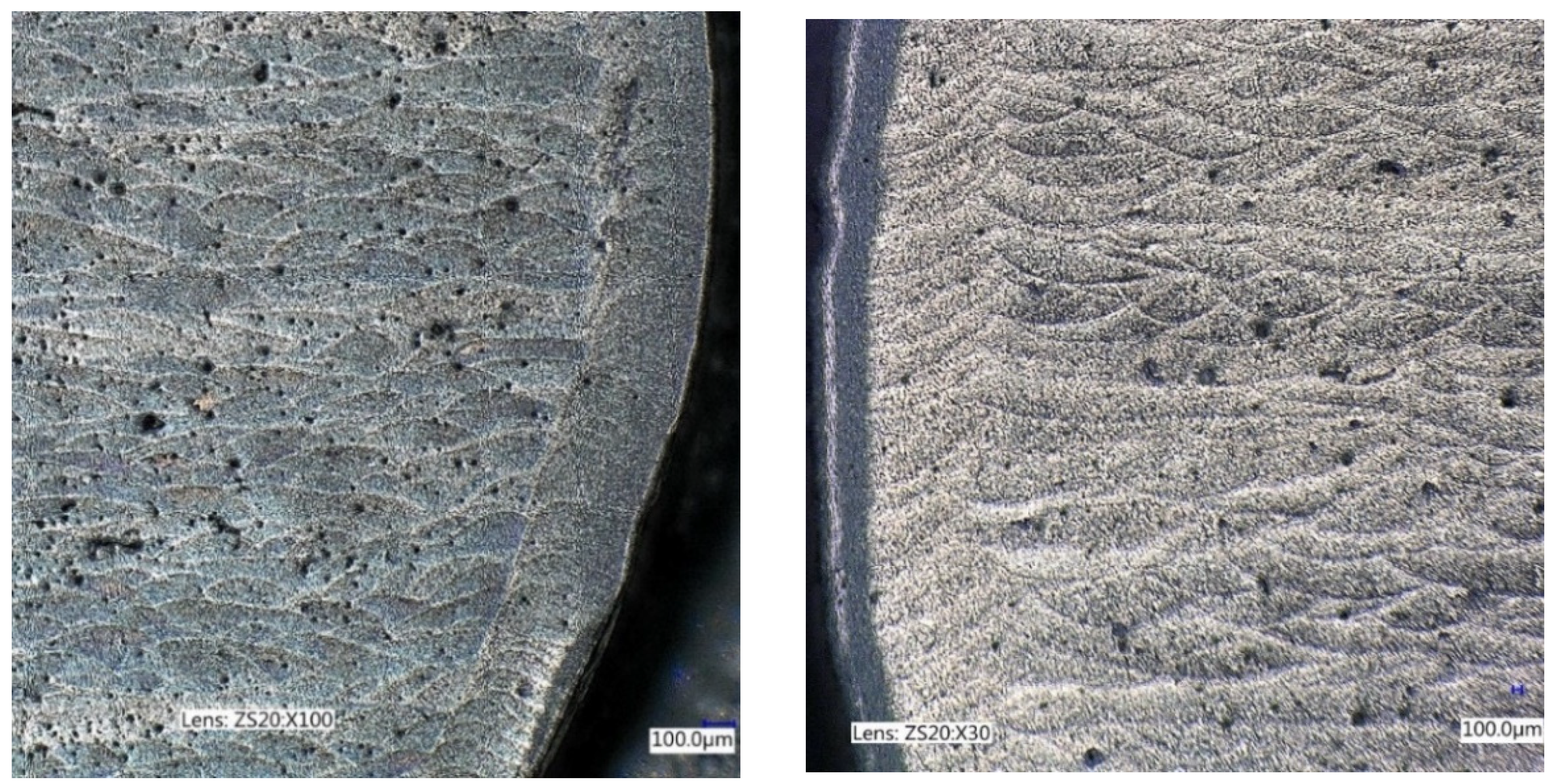
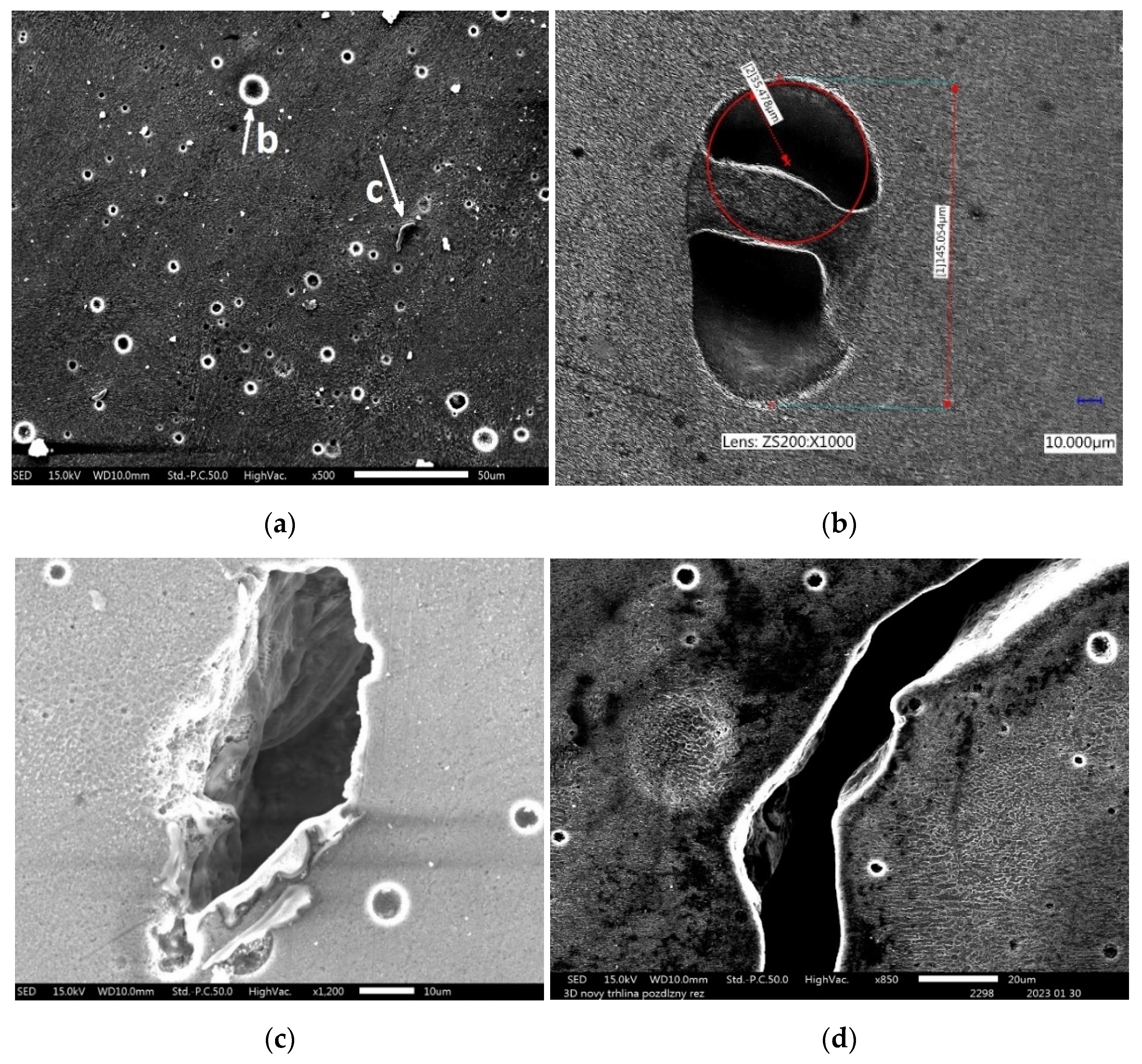
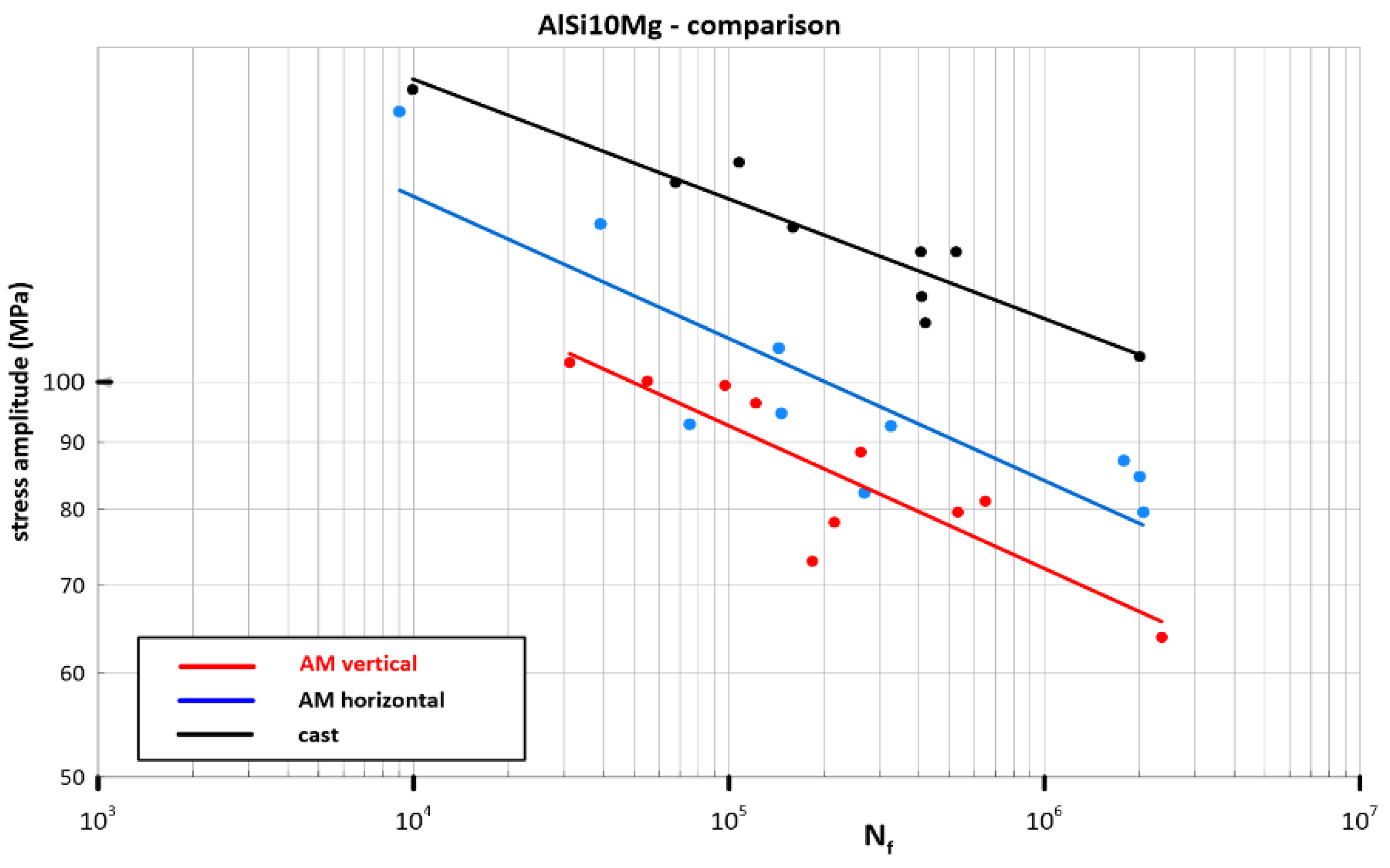
| Si (%) | Mg (%) | Fe (%) | Ti (%) | Mn (%) | Cu (%) | Zn (%) | Cr (%) | |
|---|---|---|---|---|---|---|---|---|
| Conventional metallurgy | 10.20 | 0.346 | 0.112 | 0.121 | 0.046 | 0.0017 | 0.02 | 0.002 |
| Additive manufacturing | 10.1 | 0.38 | 0.09 | <0.03 | <0.03 | <0.03 | <0.03 | - |
| AlSi10Mg | 45° | 90° | 180° |
|---|---|---|---|
| Ultimate stress (MPa) | 360–370 (367) | 325–390 (366) | 316–350 (336) |
| Yield stress (MPa) | 230–268 (252) | 220–260 (248) | 224–250 (236) |
| Ductility (%) | 6.0–9.6 (8.2) | 5.6–10.0 (7.63) | 10.0–16.3 (12.83) |
| Material | Cyclic Axial | |||||
|---|---|---|---|---|---|---|
| RL | 97.5% PI | 2.5% PI | ||||
| σf’ (MPa) | bσ (-) | σf’ (MPa) | bσ (-) | σf´ (MPa) | bσ (-) | |
| AM_Vertical | 553 | −0.1442 | 595 | −0.1404 | 511 | −0.1483 |
| AM_Horizontal | 651 | −0.1449 | 956 | −0.1587 | 472 | −0.1332 |
| Cast | 488 | −0.1028 | 539 | −0.1044 | 443 | −0.1012 |
Disclaimer/Publisher’s Note: The statements, opinions and data contained in all publications are solely those of the individual author(s) and contributor(s) and not of MDPI and/or the editor(s). MDPI and/or the editor(s) disclaim responsibility for any injury to people or property resulting from any ideas, methods, instructions or products referred to in the content. |
© 2023 by the authors. Licensee MDPI, Basel, Switzerland. This article is an open access article distributed under the terms and conditions of the Creative Commons Attribution (CC BY) license (https://creativecommons.org/licenses/by/4.0/).
Share and Cite
Chmelko, V.; Šulko, M.; Škriniarová, J.; Margetin, M.; Gašparík, M.; Koščo, T.; Semeš, M. Strength and Cyclic Properties of Additive vs. Conventionally Produced Material AlSi10Mg. Materials 2023, 16, 2598. https://doi.org/10.3390/ma16072598
Chmelko V, Šulko M, Škriniarová J, Margetin M, Gašparík M, Koščo T, Semeš M. Strength and Cyclic Properties of Additive vs. Conventionally Produced Material AlSi10Mg. Materials. 2023; 16(7):2598. https://doi.org/10.3390/ma16072598
Chicago/Turabian StyleChmelko, Vladimír, Miroslav Šulko, Jaroslava Škriniarová, Matúš Margetin, Marek Gašparík, Tomáš Koščo, and Marián Semeš. 2023. "Strength and Cyclic Properties of Additive vs. Conventionally Produced Material AlSi10Mg" Materials 16, no. 7: 2598. https://doi.org/10.3390/ma16072598
APA StyleChmelko, V., Šulko, M., Škriniarová, J., Margetin, M., Gašparík, M., Koščo, T., & Semeš, M. (2023). Strength and Cyclic Properties of Additive vs. Conventionally Produced Material AlSi10Mg. Materials, 16(7), 2598. https://doi.org/10.3390/ma16072598









